Enermax MaxTytan 1250W PSU Review
Why you can trust Tom's Hardware
Transient Response Tests
Advanced Transient Response Tests
For details on our transient response testing, please click here.
Ιn these tests, we monitor the EDT1250EWT's response in several scenarios. First, a transient load (10A at +12V, 5A at 5V, 5A at 3.3V, and 0.5A at 5VSB) is applied for 200ms as the PSU works at 20 percent load. In the second scenario, it's hit by the same transient load while operating at 50 percent load.
In the next sets of tests, we increase the transient load on the major rails with a new configuration: 15A at +12V, 6A at 5V, 6A at 3.3V, and 0.5A at 5VSB. We also increase the load-changing repetition rate from 5 Hz (200ms) to 50 Hz (20ms). Again, this runs with the PSU operating at 20 and 50 percent load.
The last tests are even tougher. Although we keep the same loads, the load-changing repetition rate rises to 1 kHz (1ms).
In all of the tests, we use an oscilloscope to measure the voltage drops caused by the transient load. The voltages should remain within the ATX specification's regulation limits.
These tests are crucial because they simulate the transient loads a PSU is likely to handle (such as booting a RAID array or an instant 100 percent load of CPU/GPUs). We call these "Advanced Transient Response Tests," and they are designed to be very tough to master, especially for a PSU with a capacity of less than 500W.
Advanced Transient Response at 20 Percent – 200ms
| Voltage | Before | After | Change | Pass/Fail |
|---|---|---|---|---|
| 12V | 12.009V | 11.934V | 0.62% | Pass |
| 5V | 5.061V | 5.011V | 0.99% | Pass |
| 3.3V | 3.291V | 3.206V | 2.58% | Pass |
| 5VSB | 5.041V | 5.002V | 0.77% | Pass |
Advanced Transient Response at 20 Percent – 20ms
| Voltage | Before | After | Change | Pass/Fail |
|---|---|---|---|---|
| 12V | 12.009V | 11.925V | 0.70% | Pass |
| 5V | 5.061V | 4.999V | 1.23% | Pass |
| 3.3V | 3.291V | 3.196V | 2.89% | Pass |
| 5VSB | 5.041V | 4.988V | 1.05% | Pass |
Advanced Transient Response at 20 Percent – 1ms
| Voltage | Before | After | Change | Pass/Fail |
|---|---|---|---|---|
| 12V | 12.008V | 11.914V | 0.78% | Pass |
| 5V | 5.060V | 4.988V | 1.42% | Pass |
| 3.3V | 3.291V | 3.197V | 2.86% | Pass |
| 5VSB | 5.041V | 4.976V | 1.29% | Pass |
Advanced Transient Response at 50 Percent – 200ms
| Voltage | Before | After | Change | Pass/Fail |
|---|---|---|---|---|
| 12V | 11.987V | 11.944V | 0.36% | Pass |
| 5V | 5.051V | 5.001V | 0.99% | Pass |
| 3.3V | 3.281V | 3.194V | 2.65% | Pass |
| 5VSB | 5.024V | 4.987V | 0.74% | Pass |
Advanced Transient Response at 50 Percent – 20ms
| Voltage | Before | After | Change | Pass/Fail |
|---|---|---|---|---|
| 12V | 11.986V | 11.904V | 0.68% | Pass |
| 5V | 5.051V | 4.993V | 1.15% | Pass |
| 3.3V | 3.281V | 3.187V | 2.86% | Pass |
| 5VSB | 5.024V | 4.986V | 0.76% | Pass |
Advanced Transient Response at 50 Percent – 1ms
| Voltage | Before | After | Change | Pass/Fail |
|---|---|---|---|---|
| 12V | 11.985V | 11.896V | 0.74% | Pass |
| 5V | 5.051V | 4.990V | 1.21% | Pass |
| 3.3V | 3.281V | 3.187V | 2.86% | Pass |
| 5VSB | 5.024V | 4.958V | 1.31% | Pass |



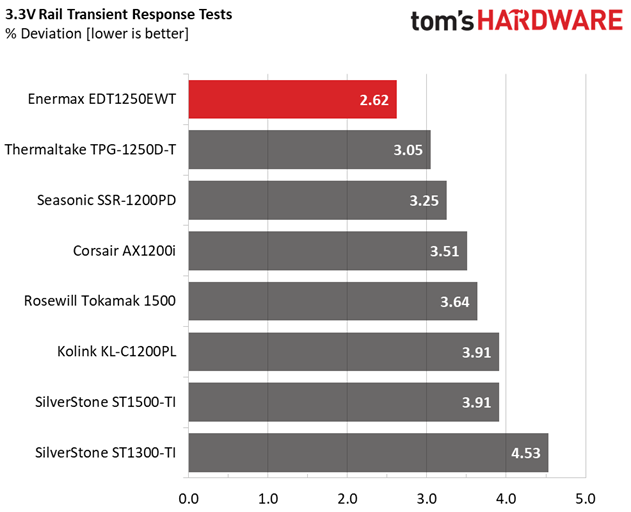
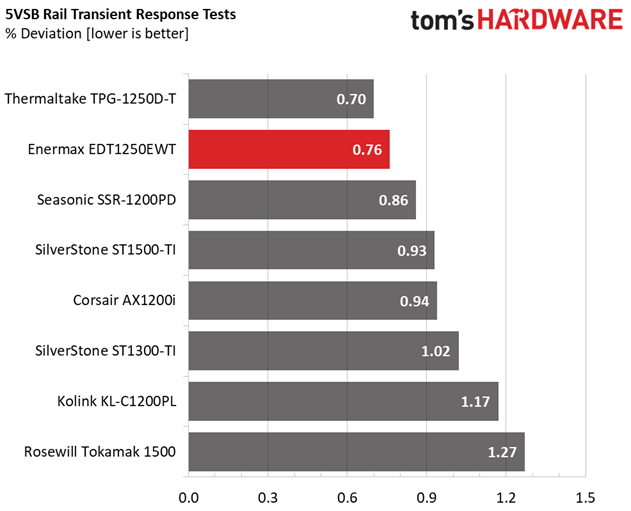
The transient response on every rail is good, since the deviations are kept low. Nonetheless, it would be nice if the voltage levels at 3.3V were higher, since we notice that they drop below 3.2V as soon as we apply the transient load. While our measurements remain above the lower limit (3.14V), we don't want to see below 3.2V on this rail during our tests.
Get Tom's Hardware's best news and in-depth reviews, straight to your inbox.
Finally, the +12V rail, which is what matters the most, performs well. It remains within 1% in all tests.
Here are the oscilloscope screenshots we took during Advanced Transient Response Testing:
Transient Response At 20 Percent Load – 200ms


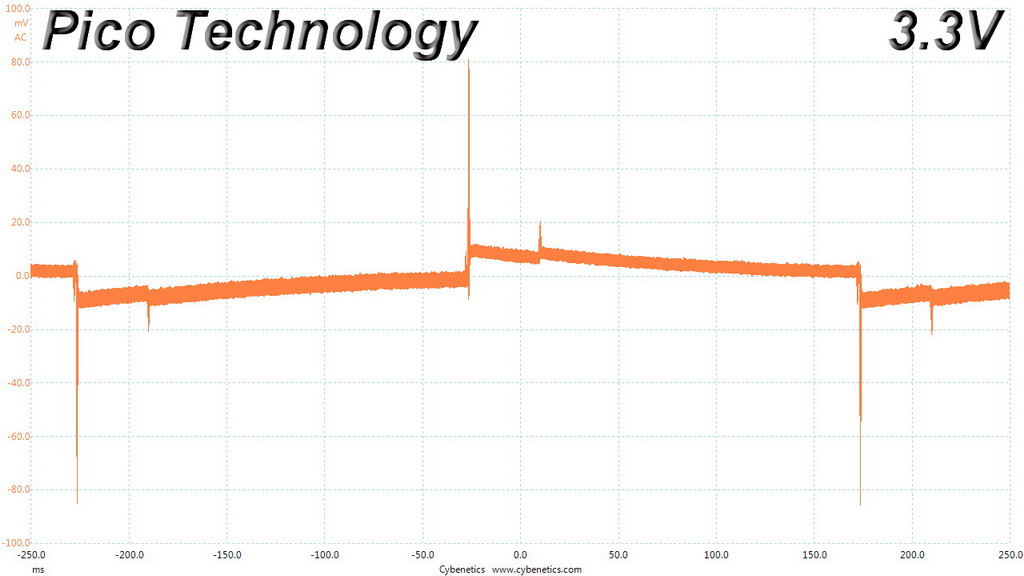

Transient Response At 20 Percent Load – 20ms


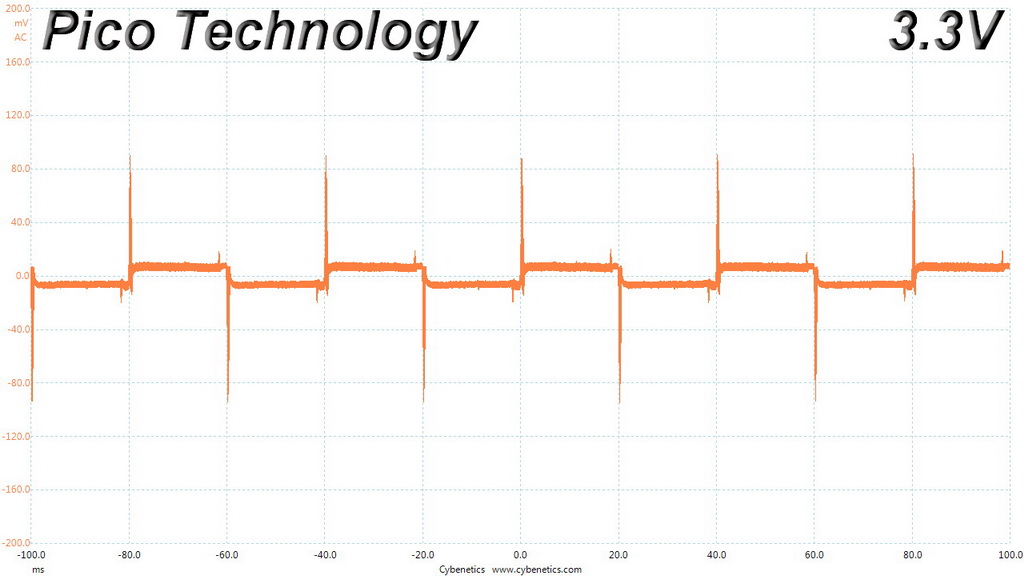

Transient Response At 20 Percent Load – 1ms
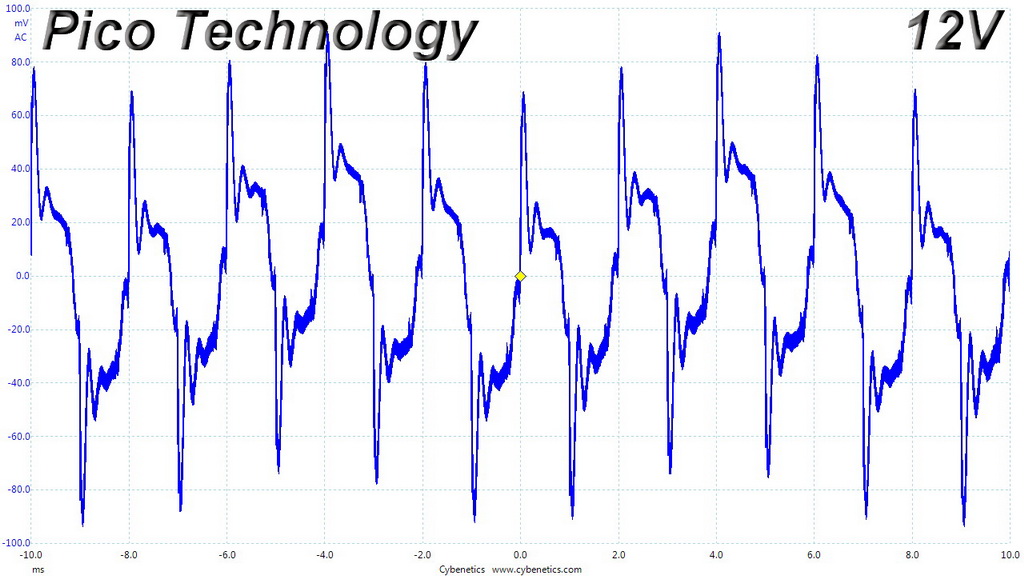



Transient Response At 50 Percent Load – 200ms




Transient Response At 50 Percent Load – 20ms




Transient Response At 50 Percent Load – 1ms




Turn-On Transient Tests
In the next set of tests, we measured the EDT1250EWT's response in simpler transient load scenarios—during its power-on phase.
For our first measurement, we turned the EDT1250EWT off, dialed in the maximum current the 5VSB rail could output, and switched the PSU back on. In the second test, we dialed the maximum load the +12V rail could handle and started the 1250W supply while it was in standby mode. In the last test, while the PSU was completely switched off (we cut off the power or switched the PSU off), we dialed the maximum load the +12V rail could handle before switching it back on from the loader and restoring power. The ATX specification states that recorded spikes on all rails should not exceed 10 percent of their nominal values (+10 percent for 12V is 13.2V, and 5.5 V for 5V).



The slope is smooth at 5VSB, while there are no voltage overshoots or spikes during the second test. During the last test, there is a voltage overshoot and a small step before it, though neither incident worries us.
MORE: Best Power Supplies
MORE: How We Test Power Supplies
MORE: All Power Supply Content
Current page: Transient Response Tests
Prev Page Cross-Load Tests & Infrared Images Next Page Ripple Measurements
Aris Mpitziopoulos is a contributing editor at Tom's Hardware, covering PSUs.